

Renewable energy commercialization. Global New Investments in Renewable Energy[1] Renewable energy commercialization involves the deployment of three generations of renewable energy technologies dating back more than 100 years.
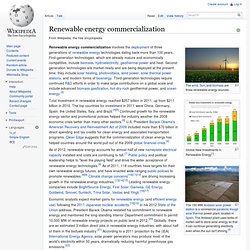
First-generation technologies, which are already mature and economically competitive, include biomass, hydroelectricity, geothermal power and heat. Second-generation technologies are market-ready and are being deployed at the present time; they include solar heating, photovoltaics, wind power, solar thermal power stations, and modern forms of bioenergy. Third-generation technologies require continued R&D efforts in order to make large contributions on a global scale and include advanced biomass gasification, hot-dry-rock geothermal power, and ocean energy.[3] Total investment in renewable energy reached $257 billion in 2011, up from $211 billion in 2010.
Environmental epidemiology. Environmental epidemiology is the branch of epidemiology concerned with discovery of the environmental exposures that contribute to or protect against injuries, illnesses, developmental conditions, disabilities, and deaths; and identification of public health and health care actions to avoid, prepare for, and effectively manage the risks associated with harmful exposures.
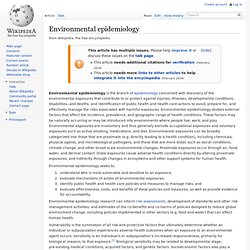
Environmental epidemiology studies external factors that affect the incidence, prevalence, and geographic range of health conditions. These factors may be naturally occurring or may be introduced into environments where people live, work, and play. Environmental exposures are involuntary and thus generally exclude occupational exposures and voluntary exposures such as active smoking, medications, and diet. Environmental epidemiology seeks to: ISO 19011. ISO 19011 is an international standard that sets forth guidelines for: management systems auditing It is developed by the International Organization for Standardization.
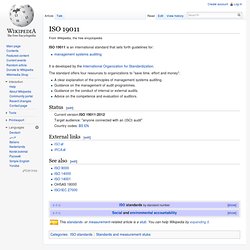
The standard offers four resources to organizations to "save time, effort and money": Centre for Social and Environmental Accounting Research. The Centre for Social and Environmental Accounting Research (CSEAR) is a research and networking institution in the field of social accounting.

It combines more than 600 active members, fellows and associates in over 30 countries. Based at the University of St Andrews in Scotland, CSEAR's primary objective is to gather and make available information about the practice and theory of social and environmental accounting and reporting. In doing so, CSEAR’s international network supports students, practitioners, scholars and educationalists in all aspects of the education, research and practice of social, environmental and sustainability accounting, reporting, auditing, finance and taxation.
Activities[edit] As a network institution, CSEAR provides a database of academics and practitioners around the world who share an interest in social and environmental accounting. CSEAR also maintains a specialist library within the University of St Andrews' School of Management. Corporate sustainability. Corporate sustainability is a business approach that creates long-term consumer and employee value by creating a "green" strategy aimed toward the natural environment and taking into consideration every dimension of how a business operates in the social, cultural, and economic environment.
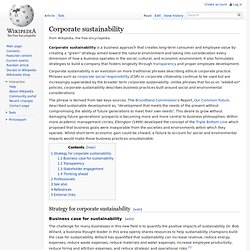
It also formulates strategies to build a company that fosters longevity through transparency and proper employee development. Global Reporting Initiative. Logo of Global Reporting Initiative The Global Reporting Initiative (GRI) is a non-profit organization that promotes economic sustainability.
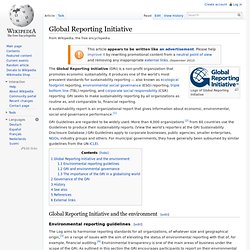
Socially responsible investing. Socially responsible investing (SRI), also known as sustainable, socially conscious, "green" or ethical investing, is any investment strategy which seeks to consider both financial return and social good.
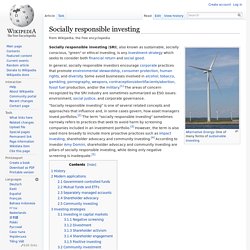
"Socially responsible investing" is one of several related concepts and approaches that influence and, in some cases govern, how asset managers invest portfolios.[2] The term "socially responsible investing" sometimes narrowly refers to practices that seek to avoid harm by screening companies included in an investment portfolio.[3] However, the term is also used more broadly to include more proactive practices such as impact investing, shareholder advocacy and community investing.[4] According to investor Amy Domini, shareholder advocacy and community investing are pillars of socially responsible investing, while doing only negative screening is inadequate.[5]
United Nations Global Compact. The Global Compact is the world's largest corporate citizenship initiative with two objectives: "Mainstream the ten principles in business activities around the world" and "Catalyse actions in support of broader UN goals, such as the Millennium Development Goals (MDGs).
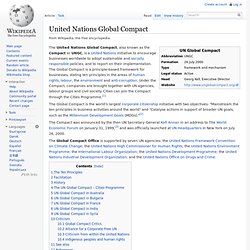
"[2] The Compact was announced by the then UN Secretary-General Kofi Annan in an address to The World Economic Forum on January 31, 1999,[3] and was officially launched at UN Headquarters in New York on July 26, 2000. The Global Compact Office is supported by seven UN agencies: the United Nations Framework Convention on Climate Change; the United Nations High Commissioner for Human Rights; the United Nations Environment Programme; the International Labour Organization; the United Nations Development Programme; the United Nations Industrial Development Organization; and the United Nations Office on Drugs and Crime. The Ten Principles[edit] The Global Compact was initially launched with nine Principles. Anti-Corruption.
Social return on investment. Social return on investment (SROI) is a principles-based method for measuring extra-financial value (i.e., environmental and social value not currently reflected in conventional financial accounts) relative to resources invested.
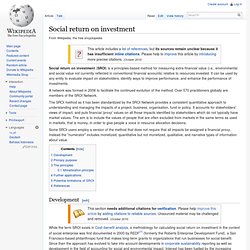
It can be used by any entity to evaluate impact on stakeholders, identify ways to improve performance, and enhance the performance of investments. A network was formed in 2006 to facilitate the continued evolution of the method. Over 570 practitioners globally are members of the SROI Network. The SROI method as it has been standardized by the SROI Network provides a consistent quantitative approach to understanding and managing the impacts of a project, business, organisation, fund or policy. It accounts for stakeholders' views of impact, and puts financial 'proxy' values on all those impacts identified by stakeholders which do not typically have market values. Socially responsible investing. Social accounting. Social accounting (also known as social accounting and auditing, social and environmental accounting, corporate social reporting, corporate social responsibility reporting, non-financial reporting or accounting) is the process of communicating the social and environmental effects of organizations' economic actions to particular interest groups within society and to society at large.[1] Social accounting is commonly used in the context of business, or corporate social responsibility (CSR), although any organisation, including NGOs, charities, and government agencies may engage in social accounting.
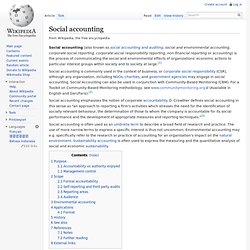
Social Accounting can also be used in conjunction with Community-Based Monitoring (CBM). For a Toolkit on Community-Based Monitoring methodology, see www.communitymonitoring.org (Available in English and Dari/Farsi).[2] Social accounting emphasises the notion of corporate accountability. D. Sustainability metrics and indices. Sustainable development indicators (SDI) are measures of sustainability, and attempt to quantify beyond the generic concept. Though there are disagreements among those from different disciplines (and influenced by different political beliefs about the nature of the good society), these disciplines and international organizations have each offered measures or indicators of how to measure the concept.
Sustainability reporting. A sustainability report is an organizational report that gives information about economic, environmental, social and governance performance.[1] Sustainability reporting [2] is not just report generation of collected data it is a method to internalize and improve an organization’s commitment to sustainable development in a way that can be demonstrated to both internal and external stakeholders. Organizations must ensure a robust system for sustainability management and reporting with regard to: TransparencyTraceabilityCompliance Corporate sustainability reporting has a long history going back to environmental reporting. Conservation biology. Efforts are being taken to preserve the natural characteristics of Hopetoun Falls, Australia while continuing to allow visitor access Conservation biology is the scientific study of the nature and status of Earth's biodiversity with the aim of protecting species, their habitats, and ecosystems from excessive rates of extinction and the erosion of biotic interactions.[1][2][3] It is an interdisciplinary subject drawing on natural and social sciences, and the practice of natural resource management.[4][5][6][7] The conservation ethic is based on the findings of conservation biology.
Use of the term[edit] The term conservation biology was introduced as the title of a conference held at the University of California, San Diego in La Jolla, California in 1978 organized by biologists Bruce Wilcox and Michael E. Soulé. Forest. Etymology[edit] Since the 1200s this forest has had special use and protection in Poland. In this view from space, different coloration can indicate different functions.[4] The word "forest" comes from Middle English forest, from Old French forest (also forès) "forest, vast expanse covered by trees"; first introduced in English as the word for wild land set aside for hunting[5] without the necessity in definition for the existence of trees (James 1981;Muir 2000,2008).[6] Possibly a borrowing (probably via Frankish or Old High German) of the Medieval Latin word foresta "open wood", foresta was first used by Carolingian scribes in the Capitularies of Charlemagne to refer specifically to the king's royal hunting grounds.
The term was not endemic to Romance languages (e.g. native words for "forest" in the Romance languages evolved out of the Latin word silva "forest, wood" (English sylvan); cf. The exact origin of Medieval Latin foresta is obscure. Wetland. Marshes develop along the edges of rivers and lakes. Many species of frogs live in wetlands, while others visit them each year to lay eggs. Snapping turtles are one of the many kinds of turtles found in wetlands The UN Millennium Ecosystem Assessment determined that environmental degradation is more prominent within wetland systems than any other ecosystem on Earth. [citation needed] International conservation efforts are being used in conjunction with the development of rapid assessment tools to inform people about wetland issues.
[citation needed] Constructed wetlands are used as a water management tool and may play a role in the developing field of water-sensitive urban design. Ecology. Ecology is an interdisciplinary field that includes biology and Earth science. The word "ecology" ("Ökologie") was coined in 1866 by the German scientist Ernst Haeckel (1834–1919). Public health. Newspaper headlines from around the world about polio vaccine tests (13 April 1955) Environmental health. Ecological engineering. Environmental engineering.